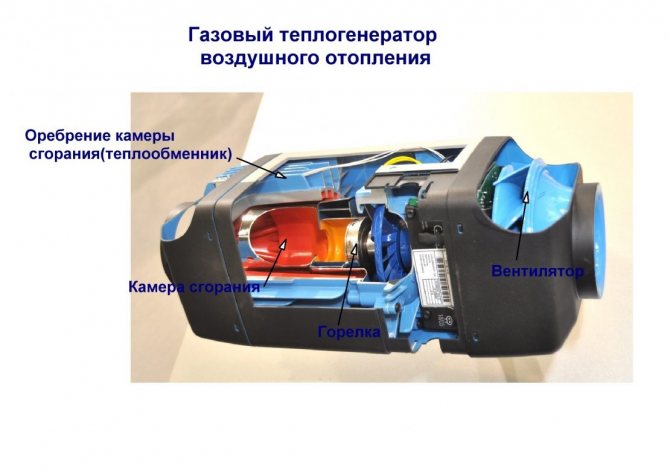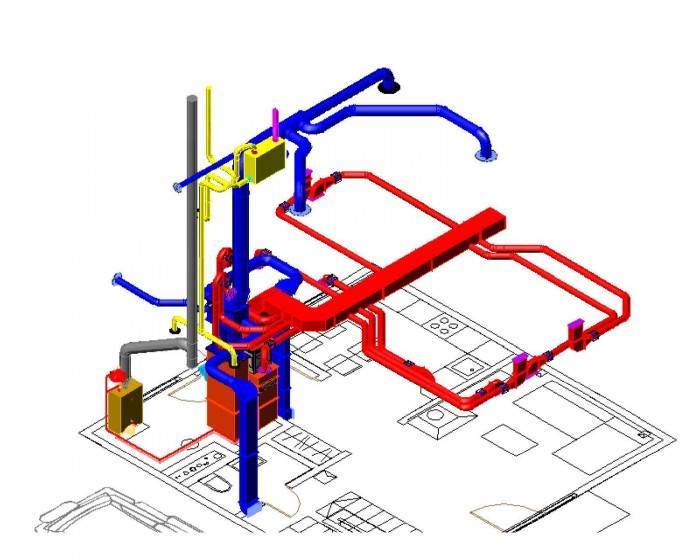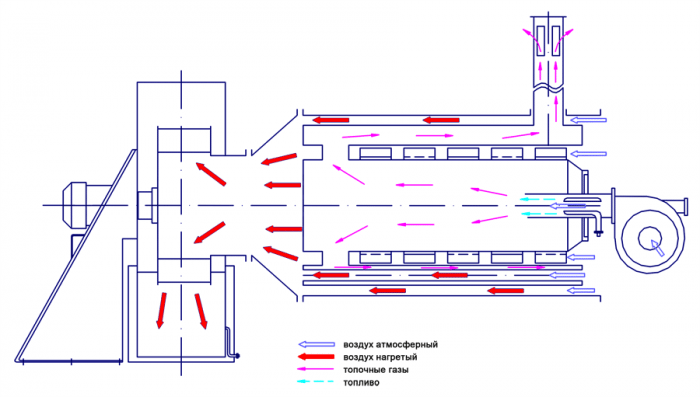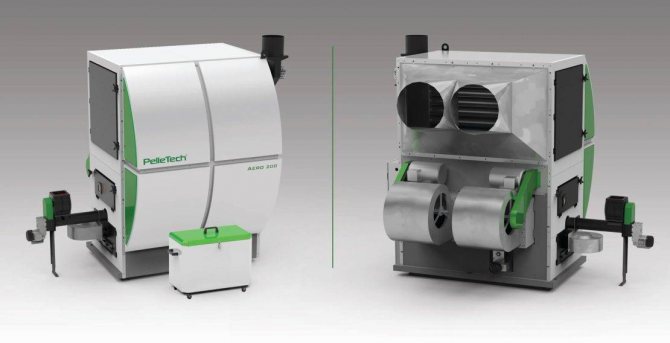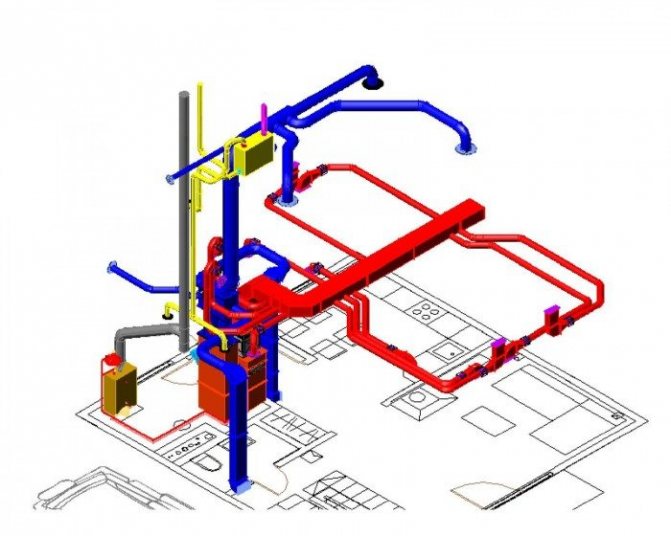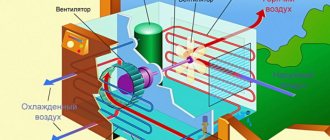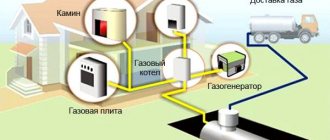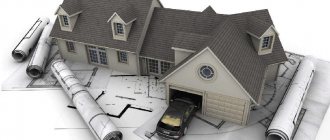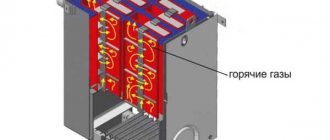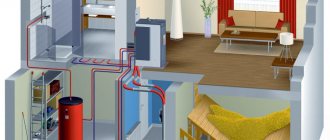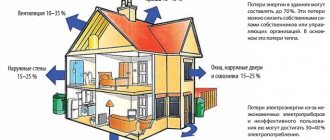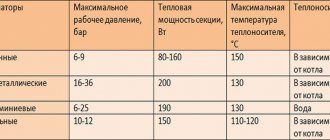Rank: 3 173

Despite the fact that the heating system of the premises is already quite developed, there are still moments that were previously missed, and therefore modern heating technologies appear, one of which is gas heat generators for air heating of a house.
So, for example, for semi-industrial premises, where previously separate small rooms for the furnace were used, mechanisms that were not expensive to use, install and purchase appeared - gas heat generators for air heating of a house. And what is perhaps the most important thing in them is that you do not need to hire an additional person who will monitor the level of warm-up.
Design features of gas heat generators
Air heating is most effective in showrooms, production facilities, film studios, car washes, poultry farms, workshops, large private houses, etc.
A standard gas heat generator for air heating operation consists of several parts that interact with each other:
- Housing... All components of the generator are hidden in it. In its lower part there is an inlet opening, and at the top there is a nozzle for already heated air.
- The combustion chamber... Fuel is burned here, due to which the coolant is heated. It is located above the supply fan.
- Burner... The device supplies compressed oxygen to the combustion chamber. Thanks to this, the combustion process is supported.
- Fan... It circulates heated air throughout the room. Located behind the inlet grille at the bottom of the cabinet.
- Metal heat exchanger... A compartment from which heated air is supplied to the outside. It is located above the combustion chamber.
- Hoods and filters... Limit the ingress of flammable gases into the room.
Air is supplied to the case by means of a fan. Vacuum is generated in the area of the supply grille.
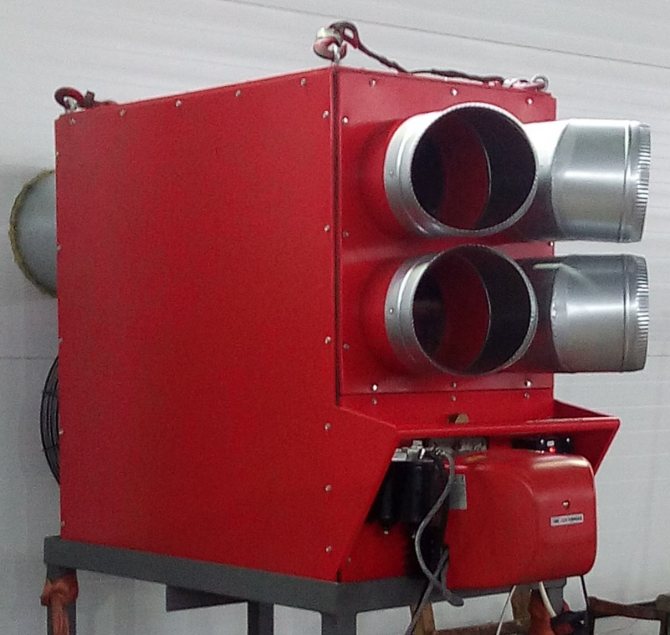

An air heating device costs 3-4 times cheaper than a "water" circuit. In addition, airborne options do not threaten the loss of thermal energy during transportation due to hydraulic resistance.
The head is concentrated opposite the combustion chamber. By oxidizing liquefied or natural gas, the burner generates heat.
The energy from the combustion gas is absorbed by a metal heat exchanger. As a result, air circulation in the housing becomes difficult, its speed is lost, but the temperature rises.
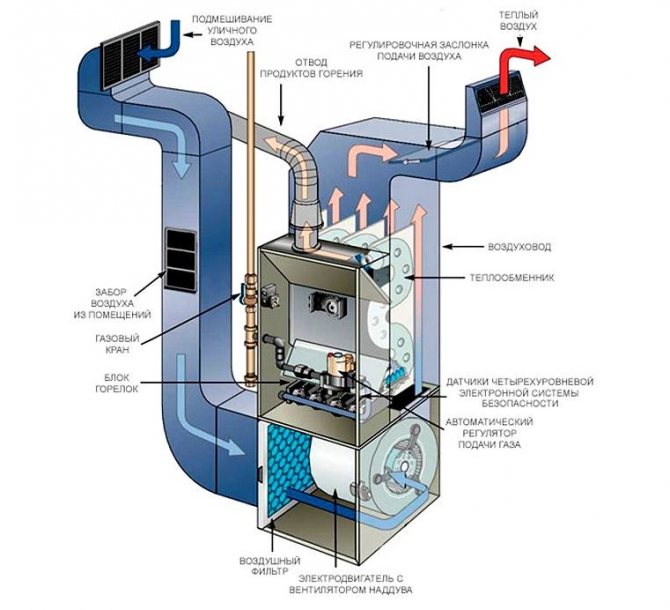

Knowing the power of the heating element, you can calculate the size of the hole, which will provide the necessary air flow
Without a heat exchanger, most of the energy from the combustion gas would be wasted and the burner efficiency would be lower.
This heat exchange heats the air up to 40-60 ° C, after which it is supplied to the room by means of a nozzle or bell, which are provided in the upper part of the housing.
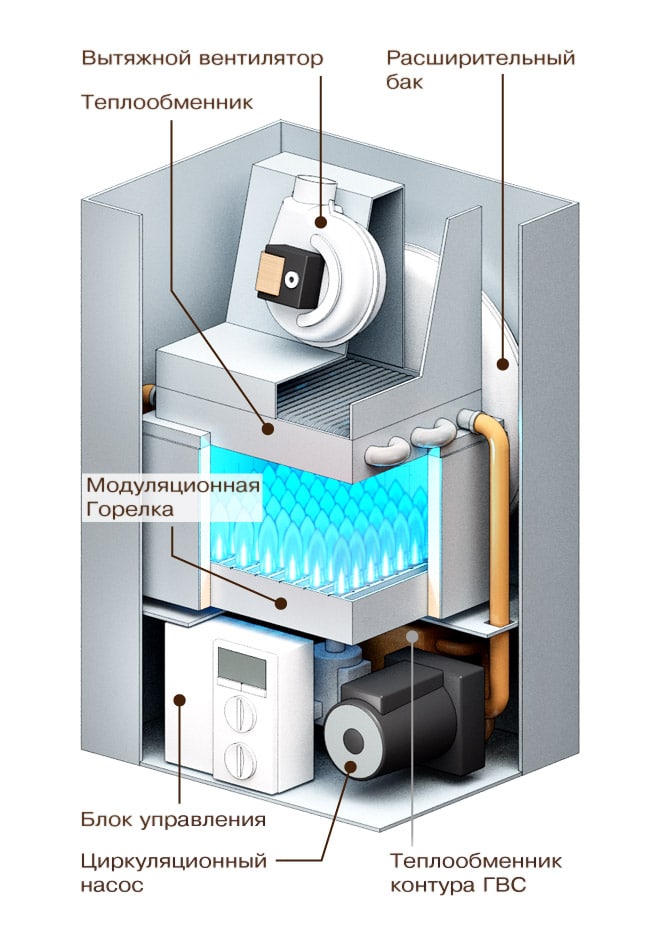

Fuel is supplied to the combustion chamber, where, during the combustion process, a heat exchanger heats up, transferring thermal energy to the coolant
The environmental friendliness of the equipment, as well as its safety, make it possible to use heat generators in everyday life. Another advantage is the absence of liquid moving through the pipes to the convectors (batteries). The heat generated heats the air, not the water. Thanks to this, the efficiency of the device reaches 95%.
How does the heating system work?
The fan blades capture air and direct it to the heat exchanger. The air stream heated by it circulates through the building, carrying out several cycles.
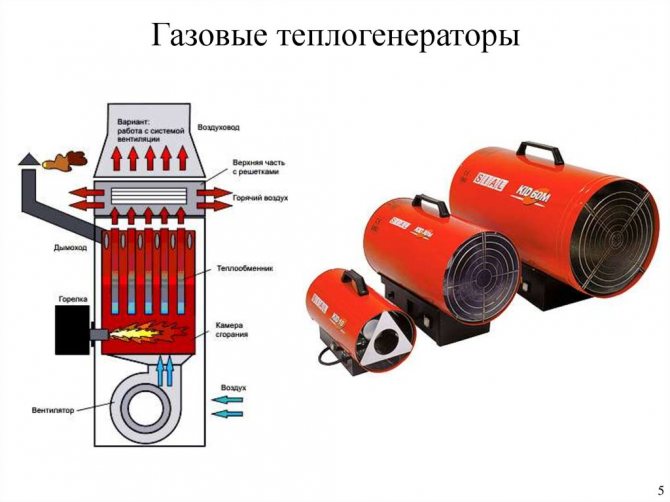

The main advantage of the design of the gas heat generator is that the location of the chambers and compartments prevents the mixing of the decay products of the spent fuel with the air from the room.
During the operation of the equipment, there is no need to fear that the pipe will burst and you will flood your neighbors, as is often the case with water heating systems. However, in the heat-generating device itself, sensors are provided that in emergency situations (threat of breakdown) stop the fuel supply.
Heated air is supplied to the room in several ways:
- Channelless. Warm air flows freely into the treated space. During circulation, it replaces the cold one, which allows maintaining the temperature regime. The use of this type of heating is advisable in small rooms.
- Channel. By means of a system of air ducts connected to each other, the heated air moves through the air ducts, which makes it possible to simultaneously heat several rooms. It is used for heating large buildings with separate rooms.
Fan or gravity stimulates the movement of air mass. The heat generator can be installed indoors and outdoors.
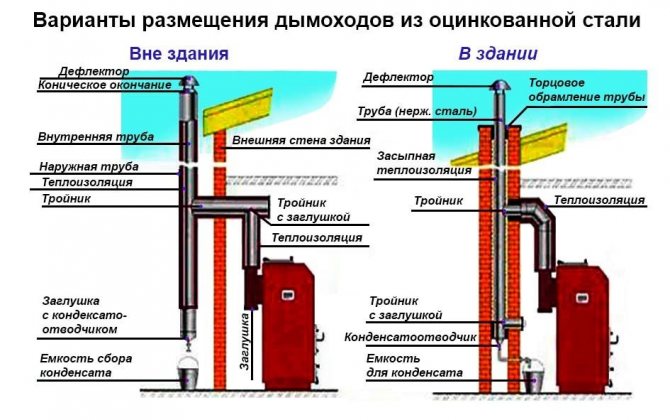

The use of air as a heat carrier makes the system as profitable as possible. The air mass is non-corrosive and is not capable of damaging any elements of the system
In order for the heating system to function correctly, the chimney must be correctly connected to the gas generator of thermal energy.
If the flue duct is not installed correctly, it will more often become clogged with soot build-up. A narrowed and clogged chimney will poorly remove toxic substances.
Profitable proposition
We offer you high quality gas air heaters in a rich assortment. For your convenience, I have prepared a detailed description of the products, which will help you familiarize yourself with a particular model in real time. We have been working in the heating market for over 16 years and during this time we have gained tremendous experience that allows us to implement projects of any complexity. If you have any questions or would like to receive additional information about the equipment and features of our company, then our qualified consultants will help you.
Equipment advantages and disadvantages
The popularity of gas heat generators is associated with a number of advantages:
- gas is the most accessible and inexpensive fuel;
- the device heats not the coolant, but the air, which makes it economical and safe;
- Efficiency - 95%, which allows you to heat a large room within an hour;
- thanks to the air duct system, you can independently adjust the volume of the heated area;
- the ability to move the device;
- all processes are automated, as a result of which any user can control and manage the system;
- the device is also used for ventilation and air conditioning of the building;
- in some models it is possible to change the burners for liquefied and natural gas;
- there is no need to carry out a pipe system and install heating radiators, as a result, the cost of the system is reduced;
- the heat generator can be installed outside the heated building;
- simplicity and speed of installation.
Some consumers are intimidated by the high cost of equipment, but the system pays for itself within one year.
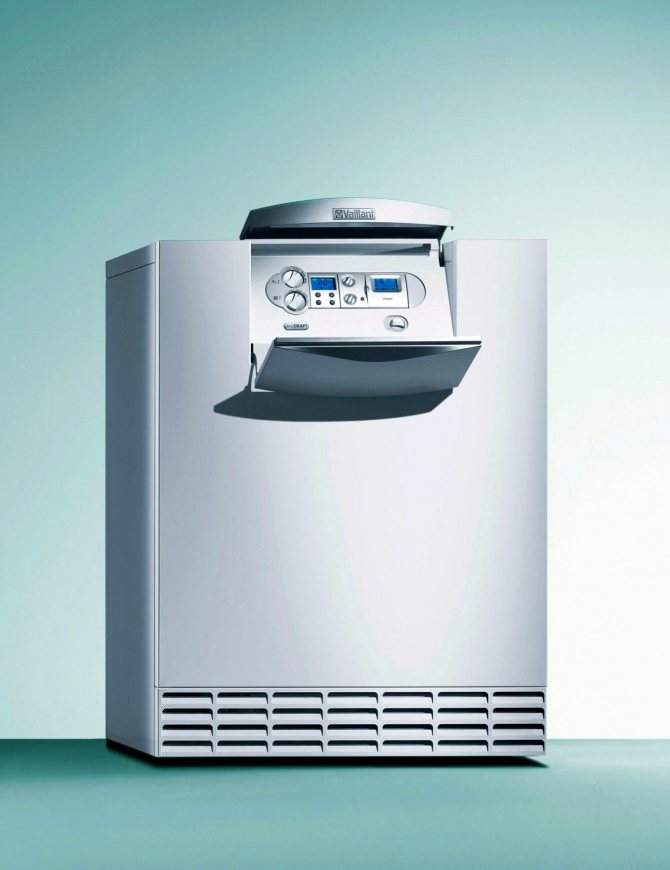

An air heating system has one drawback - rapid heat loss. The presence of temperature sensors in the gas heat generator allows you to automatically start it to maintain a comfortable temperature without human intervention
Minor disadvantages are also the need to obtain permits for connecting gas equipment and installing a chimney.
Equipment selection rules
As mentioned above, gas heat guns are presented on the market in a wide variety, which allows you to fully satisfy consumer demand. However, when choosing these devices, a number of problems arise. It is required to determine the exact power of the equipment. The difference in price between heaters of different power can be very tangible, and therefore it is necessary to accurately determine the technical characteristics. provides you with the services of competent employees who will help you with the selection and further purchase of equipment. Experts will calculate the power of the installation based on the conditions of your specific facility. This will allow you to save a lot on your purchase.
Varieties of gas heat generators
In comparison with diesel, solid fuel and universal heat generators, gas equipment for air heating is most popular.
Devices are differentiated by size and weight:
- mobile - easy to transport;
- stationary - installed in one place.
Mobile models of gas-fired heat generators are less popular, since their operation requires gas cylinders filled with liquefied propane-butane mixtures. The most striking representative of portable heating equipment is a heat gun.
Most often, heat guns are used for a one-time temperature rise on construction sites and in shopping malls. In everyday life, they are used in extreme cases (turning off the heating in the house).
Stationary models of gas heat generators can be:
- hinged - hung on brackets mounted in the walls;
- floor - installed on the floor.
Wall-mounted models are used to heat small objects, their power usually does not exceed 35 kW. Floor standing equipment is recommended for heating small areas. In the range of floor-standing units, there are models that can be mounted outside the building, i.e. on the street.


In order for the gas processing equipment of the atmospheric type to work constantly, it is necessary to ensure a constant supply of air to the combustion chamber.
Depending on the distribution of heated oxygen and the method of gas combustion, the equipment is divided into:
- horizontal;
- vertical.
For rooms with high ceilings, vertical devices are used, while rooms with low ceilings are horizontal.
About company
If you need to purchase first-class gas air heaters, but you have no idea where they could be ordered in real time, then we are ready to help you. The main direction of our activity for over 18 years has been the sale, installation and maintenance of high-quality gas heating equipment that meets all modern standards. On this page you will find a detailed description of gas heat guns. This will help you make the right choice and purchase exactly the model that best suits your specifications.
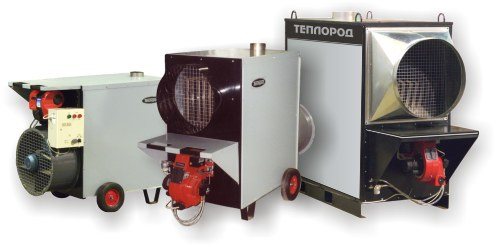

How to choose a heat generator?
When choosing heating equipment, you need to take into account a lot of details. First of all, it is important to assess the area of the heated room. The larger the building, the more powerful the heat generator should be.
The heat capacity of a building is calculated using the formula:
p = V ΔT k / 860
p is the required heat capacity;
V - heated area (the height, length and width of the room are multiplied);
ΔT is the difference in temperature indicators in the building and outside;
K - thermal insulation (indicators of the material with which the building is insulated).
Indicators of the most commonly used materials:
- double layer of brick - 1-1.9 W / m ° С;
- single layer of brick - 2-2.9 W / m ° С;
- wooden panels or corrugated board - 3-4 W / m ° С;
- modern heat and waterproofing - 0.6-0.9 W / m ° C.
The indicator of the number of kilocalories in kilowatts is 860. Generally accepted standards - for 1 kW of heat generator power, 30 cubic meters of forced air is required.
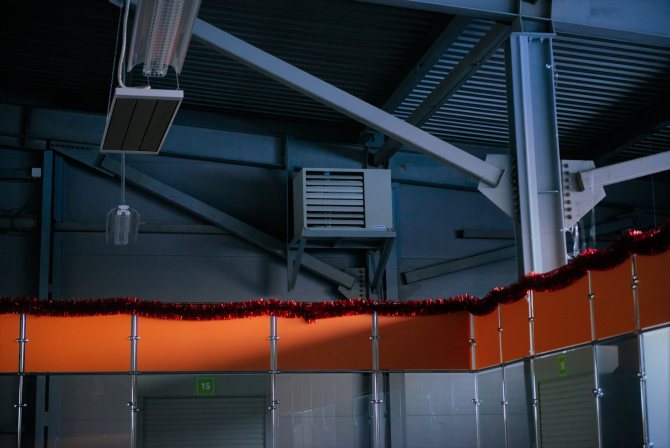

The capacity of the air heater must exceed the burner capacity by at least 15%. Such equipment is reliable and efficient in any situation. Its use reduces energy costs
Knowing the value of the heat capacity, you can select equipment that can heat the entire area of the room.
Nuances when choosing a heat generator
Before purchasing heating equipment, you must:
- equip a chimney for the release of toxic gases;
- think over a system of ventilation ducts for circulating heated air;
- use the formula to calculate the power of the device.
After completing all these steps, you can safely go for the purchase.
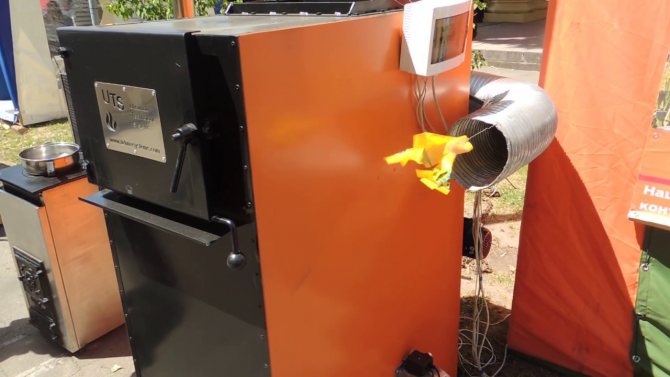

If the room has problems with the arrangement of ventilation, it is recommended to install a powerful floor generator and synchronize its operation with ventilation that draws air directly from the street.
To select a high-quality model of a gas heat generator, you need to pay attention to the following nuances:
- burner type and design - relevant if fuel change may be required;
- warranty card and technical passport - a guarantee of the purchase of original (not defective) equipment;
- high-quality components - such equipment is more expensive, but its service life is much longer.
Considering these factors, the selected heat generator will serve for many years.
Tips for choosing reliable equipment
By following simple guidelines, you can avoid purchasing a low-quality product:
- It is better to make a purchase at certified points of sale. Often, at wholesalers and on the Internet, defective products are sold under the guise of high-quality equipment. The trap is the cost halved.
- If it is not possible or you did not have time to calculate the required power of the device, then the consultants in the store will do it for you. To do this, you only need to know the area of the house, the height of the ceilings and the thickness of the walls. After making calculations, experts will offer the best model for your home.
- It is recommended to purchase brands that have positive reviews on the Internet. You can also find out in advance how the equipment behaves during operation and other features.
For home use, such models as Airmax D 28, Titan 25 (30, 35), Fuela, TG-7.5, Dragon 12 will be ideal.
Types of air heating
Air heating systems are classified into several types.
Air circulation principle: forced and natural air heating systems
— Forced system includes a fan that creates the necessary pressure to move air currents. Most often, the fan is located at the bottom of the heater.
— Natural (or gravitational) scheme acts by changing the density of the heated air. Such a system does not depend on the supply of electricity, but at the same time the circulation of air masses in the room may be unstable, it can be disturbed by an open window or a draft.
Air reuse: direct-flow and recirculation air heating systems
– Direct-flow heating... The heated air is directed to the premises, where it gives off heat, picks up carbon dioxide, allergens and microbes, and then is carried out by reverse thrust through the shaft. Instead, fresh air comes from the street, which heats up and goes through the cycle again. The direct-flow circuit is the most hygienic, but at the same time thermal energy is removed with the exhaust air. To reduce heat loss, recuperators are used, where the exhaust warm air transfers part of the heat to the incoming stream coming from the street.
– Recirculation heating differs in that the air used for the first time is not removed from the system, but is sent back to the heat exchanger, where it is warmed up for reuse. To saturate with oxygen, a mixture of fresh air from the street is used. The heat losses of the system are reduced, but hygiene is reduced, since more dust settles in the air ducts and harmful substances can enter the premises again. Recirculation is used where hygienic ventilation requirements are not so important.
By routing warm streams by premises: duct and local air heating systems
— Duct air heating... There is a duct system through which air enters and is distributed throughout the premises of the house. All parameters (temperature, humidity, air exchange rate) can be controlled using automation and a system of sensors installed in the premises. Automation saves energy costs by reducing heating when needed (for example, at night or when the occupants are away). The air heater processor can also control the air conditioner, humidifier, electronic filter and other optional equipment. At any time, these functions can be modularly added to the basic heating system at the request of the user. The combustion products are discharged to the outside through the chimney.
— Local air heating... In this case, heating equipment is installed directly in the heated area - most often such a system is used to heat industrial, warehouse premises, as well as greenhouses, garages, basements and utility rooms. The air in the room is heated directly by air heaters. For industrial and agricultural facilities, this is the most economical way of air heating, both in design and installation, and when using the system.
Installation requirements
To connect a gas heat generator for air heating at home, it is necessary to bring preparatory work and purchase:
- flexible air duct, which is a galvanized tube for circulating heated air;
- tees are needed to create an air line and connect pipes;
- for intake of cold air and supply of hot air - a grate;
- for the tightness of the line connections - aluminum tape;
- mounting fasteners;
- knife.
You should first take care of the duct.
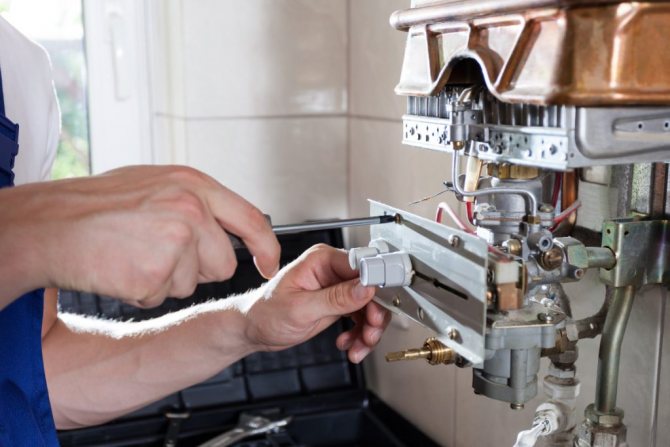

You can install a gas heat generator with your own hands, but representatives of the gas service must connect it to the gas pipeline, with which an agreement was concluded for the supply of blue fuel and maintenance of equipment
The ideal option is the design of airways - channels at the stage of building construction.
To carry out the installation of heating in a finished house, you need to erect false walls and false ceilings. Pipes will be masked in the formed niches.
Conclusions and useful video on the topic
The following video will introduce additional information on the topic:
Gas heat generators for heating systems are a highly efficient and cost-effective solution. Due to its safety, reliability and ease of use, the equipment can be used in residential buildings and at industrial facilities.
If a gas heat generator is installed in your house, you have additional information about the advantages and disadvantages of the equipment or know which generator is better to buy for heating a private house, share your experience and knowledge with readers in the comments.

